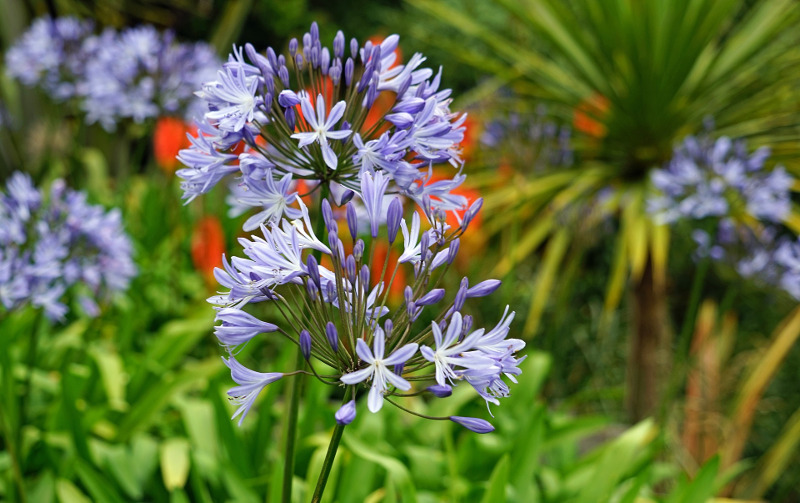Releasing the Secret to Successful Agapanthus Cultivation: Idea for a Flourishing Yard
In the world of horticulture, growing agapanthus efficiently needs a calculated strategy that includes numerous aspects of plant care. By comprehending the subtleties of agapanthus growing, one can create an environment where these plants flourish and grow perfectly.
Planting Agapanthus: Finest Practices
When planting Agapanthus, proper dirt preparation is important for ensuring effective growth and development of these stunning flowers. Agapanthus, typically called Lily of the Nile or African lily, grows in well-draining dirt with a slightly acidic to neutral pH degree - Agapanthus. Before growing, it is important to modify heavy clay soils with raw material such as compost or peat moss to boost drain and supply vital nutrients for the plants
To plant Agapanthus, select a place that gets complete sunlight to partial color, as this will certainly advertise healthy growth and plentiful blooming. Dig an opening twice the size of the plant's root sphere and place the Agapanthus at the exact same depth it was formerly growing. Delicately backfill the hole with dirt, weighing down strongly to eliminate any kind of air pockets around the roots.
Water the freshly grown Agapanthus extensively and remain to keep the dirt evenly wet, especially throughout the plant's active growing period. Agapanthus. Using a well balanced fertilizer once a month can further support the plant's development and blooming. By following these finest techniques for growing Agapanthus, you can produce a stunning display screen of these exciting blossoms in your yard
Suitable Dirt Conditions for Agapanthus
For optimal growth and growing success of Agapanthus plants, making certain the dirt conditions are perfect is critical. Agapanthus grows in well-draining soil with a somewhat acidic to neutral pH level ranging from 6.0 to 7.0. This kind of dirt enables ample water drain, protecting against waterlogging which can result in root rot. To improve soil water drainage, consider adding organic matter such as garden compost or peat moss when preparing the growing site. Moreover, Agapanthus likes soil that is rich in nutrients, so including a balanced plant food throughout the growing season can advertise healthy and balanced growth and vibrant blooms.
:max_bytes(150000):strip_icc()/agapanthus-growing-guide-7368912_hero-a3585e4f9ffe4b99a73c7ad8eb4ebe48.jpg)
Watering and Feeding Tips
To guarantee healthy growth and dynamic blooms, proper watering and feeding strategies are essential for effective Agapanthus farming. Agapanthus plants benefit from routine watering, particularly during the growing period.
When it comes to feeding Agapanthus, a well balanced fertilizer with equivalent components nitrogen, phosphorus, and potassium can be applied in the spring to advertise healthy and balanced growth and blooming. Slow-release fertilizers are perfect for giving nutrients progressively over a prolonged period. Avoid over-fertilizing, as this can bring about extreme foliage development at the cost of blooms.
In addition, including organic matter like garden compost into the dirt can improve nutrient degrees and enhance soil framework, helping in the overall wellness of the Agapanthus plants. By complying with these watering and feeding suggestions, garden enthusiasts can guarantee their Agapanthus plants grow and create stunning display screens of flowers.
Trimming and Deadheading Methods
Correct pruning and deadheading methods play an important role in keeping the health and aesthetics of Agapanthus plants, matching the important methods of watering and feeding for effective farming. Pruning Agapanthus entails removing invested flower heads, yellowing or dead leaves, and general shaping of the plant to advertise much better growth. Deadheading, the procedure of removing discolored blossoms, not only improves the plant's appearance yet likewise encourages additional growing.
When deadheading Agapanthus, it is recommended to trim off the blossom stem at the base using sharp, tidy shears. This process redirects the plant's energy from seed production back right into root and foliage growth, promoting a much healthier and extra robust plant. Routine deadheading can expand the blooming period of Agapanthus and avoid self-seeding, which can cause overcrowding.
In terms of trimming, Agapanthus generally benefits from a light trim after blossoming to clean up the plant and encourage fresh growth. Reducing the spent blossom stems and getting rid of any dead or damaged vegetation helps maintain the plant's vigor and total look. However, it is important to prevent reducing right into the crown of the plant, as this can weaken its health and wellness.

Protecting Agapanthus From Pests and Diseases
Applying efficient pest and illness administration techniques is essential to safeguarding the wellness and vigor of Agapanthus plants in cultivation. One typical pest that Discover More Here impacts Agapanthus is the Agapanthus borer, a caterpillar that tunnels into the plant, creating damage to the leaves and flowers.
In enhancement to insects, Agapanthus are at risk to diseases such as root rot and fungal fallen leave spots. By staying attentive and attending to parasite and disease problems without delay, garden enthusiasts can help their Agapanthus prosper and prosper.

Conclusion
Finally, successful growing of agapanthus needs appropriate growing strategies, excellent soil conditions, adequate why not try this out watering and fertilizing, regular pruning and deadheading, and defense from parasites and conditions. By following these tips and tricks, gardeners can Check Out Your URL make sure a flourishing garden full of gorgeous agapanthus blooms. Agapanthus. Remember to maintain regular treatment and focus to information to promote the health and longevity of these magnificent plants
When planting Agapanthus, appropriate dirt prep work is crucial for making certain effective growth and development of these beautiful flowers.Water the newly grown Agapanthus thoroughly and proceed to maintain the dirt uniformly moist, specifically throughout the plant's active expanding period.For optimum development and growing success of Agapanthus plants, making certain the dirt problems are perfect is vital. When transplanting or growing Agapanthus, guarantee the soil is well-prepared to supply the required foundation for the plants to establish themselves successfully. One typical pest that impacts Agapanthus is the Agapanthus borer, a caterpillar that passages into the plant, creating damage to the flowers and leaves.